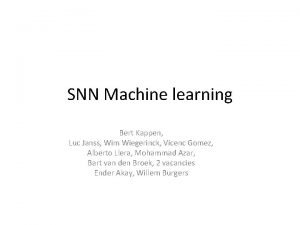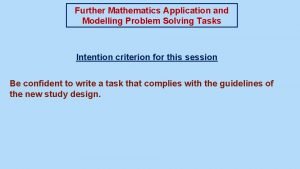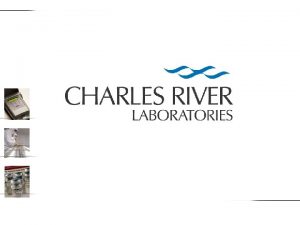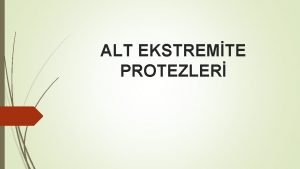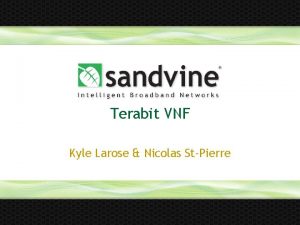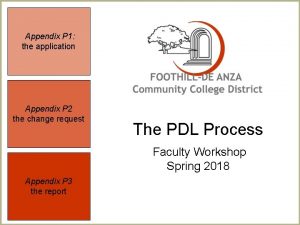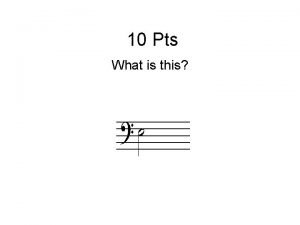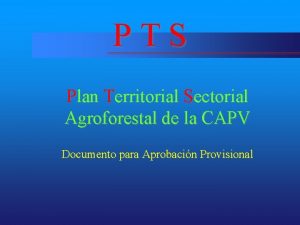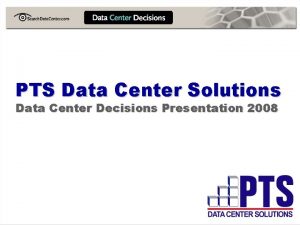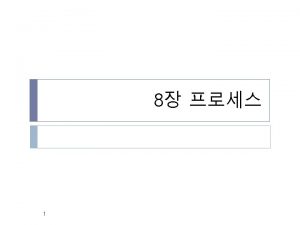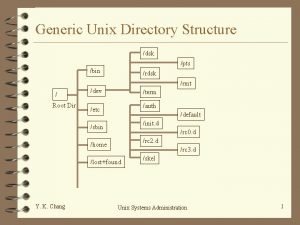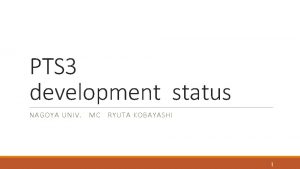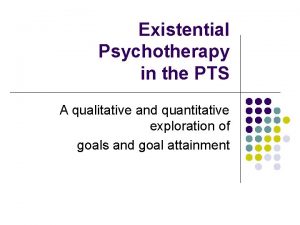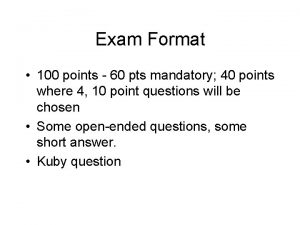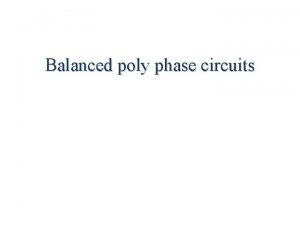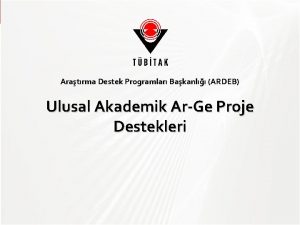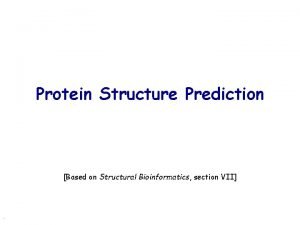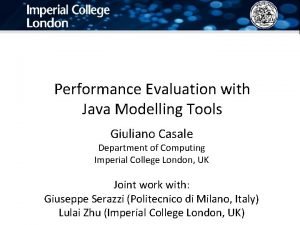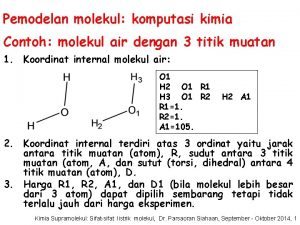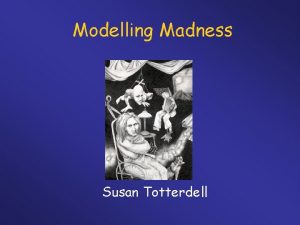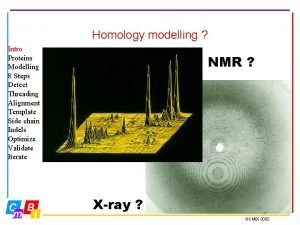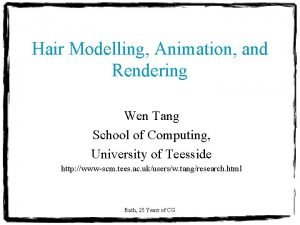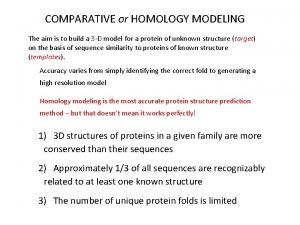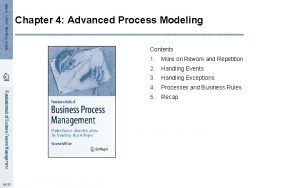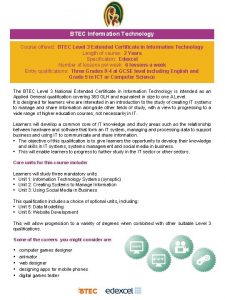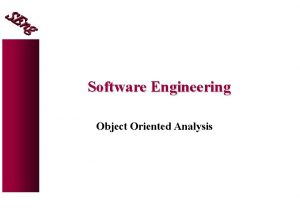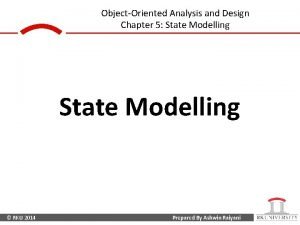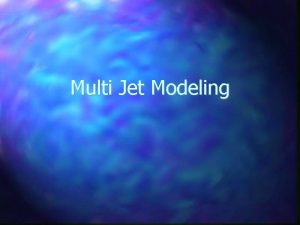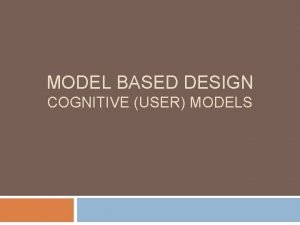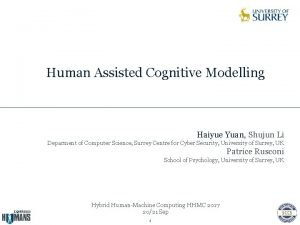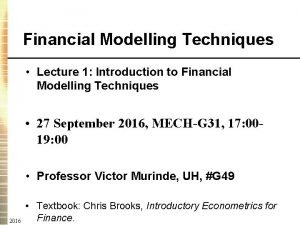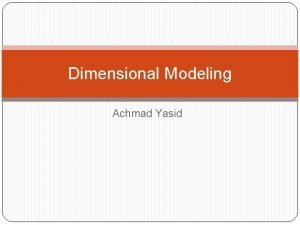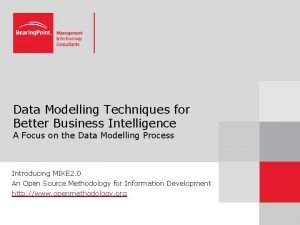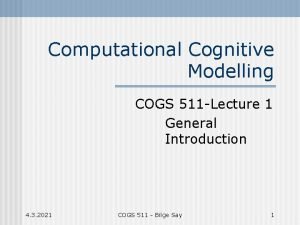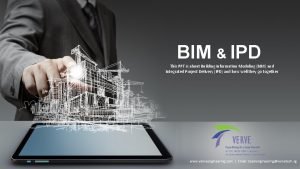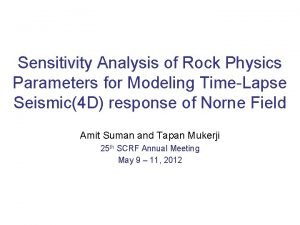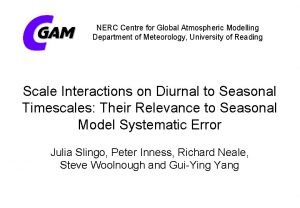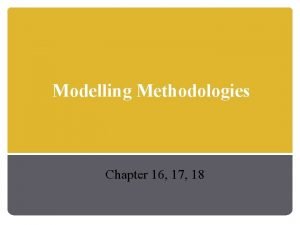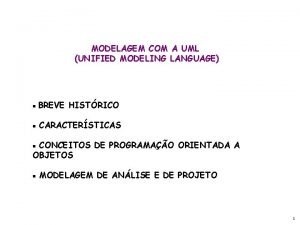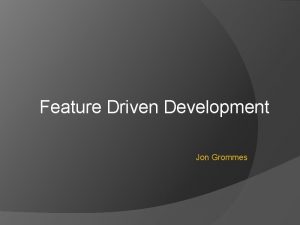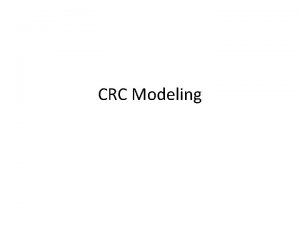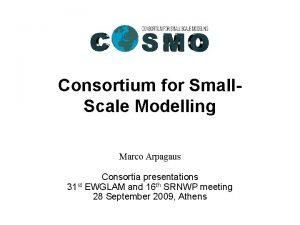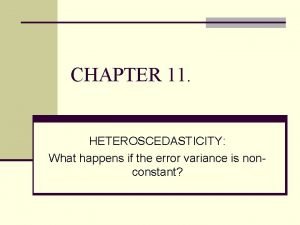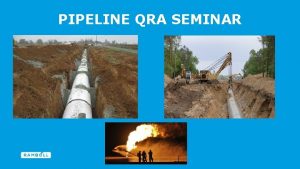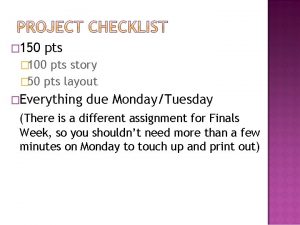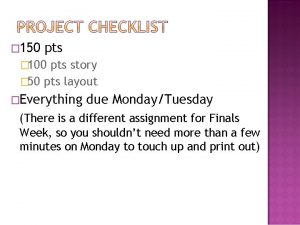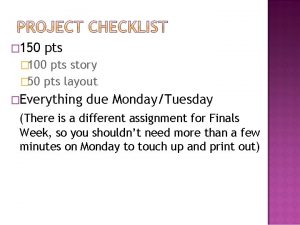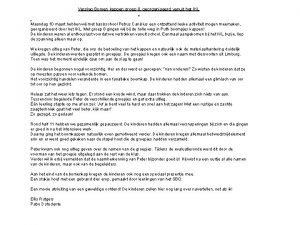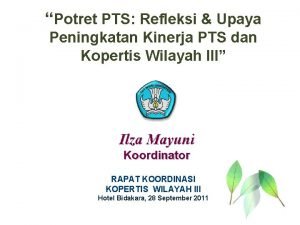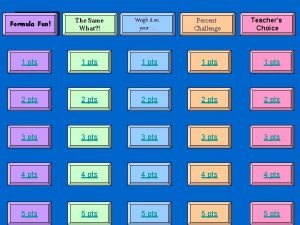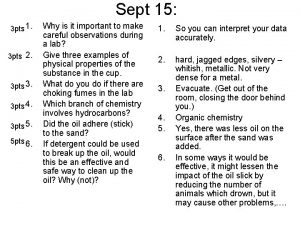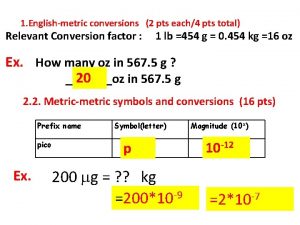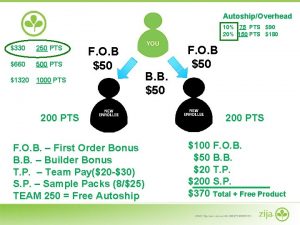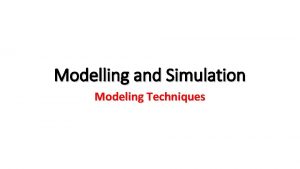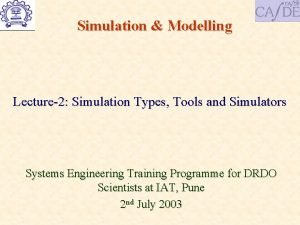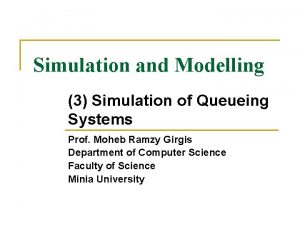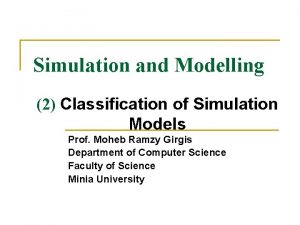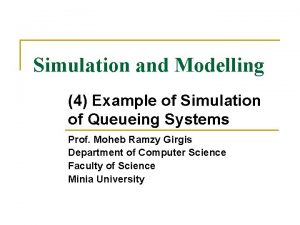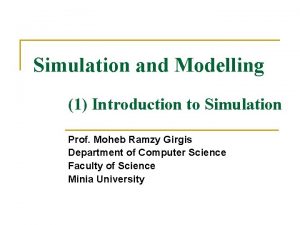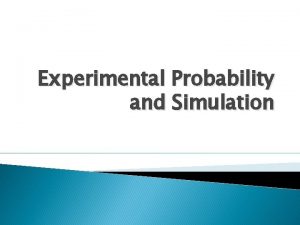Modelling and Simulation at PTS J Kappen PTS


































![Solids and Stickies Balance Coarse Screening Dump chest solids flow [kg/min] macro-stickies load (INGEDE Solids and Stickies Balance Coarse Screening Dump chest solids flow [kg/min] macro-stickies load (INGEDE](https://slidetodoc.com/presentation_image/239c8f291b4fed33e4d4d82f0f1e7b7d/image-35.jpg)





























- Slides: 64

Modelling and Simulation at PTS J. Kappen PTS Munich www. ptspaper. de

Agenda § The PTS simulation approach § Use of IDEAS in paper mill optimisation projects – – Steady state water loop optimisation – The “loop” object Heat balance optimisation Dynamic stock and water optimisation – The Matlab link Stock preparation – Extension of the “sorter” object § Beyond IDEAS – Measurement of the accuracy of dynamic models – Modelling the properties of paper: CAPD – Modelling the wet end chemistry § A look into the future § European networking activities – COST E 36 © PTS Munich

Agenda § The PTS simulation approach § Use of IDEAS in paper mill optimisation projects – – Steady state water loop optimisation – The “loop” object Heat balance optimisation Dynamic stock and water optimisation – The Matlab link Stock preparation – Extension of the “sorter” object § Beyond IDEAS – Measurement of the accuracy of dynamic models – Modelling the properties of paper: CAPD – Modelling the wet end chemistry § A look into the future § European networking activities – COST E 36 © PTS Munich

PTS Simulation Activities § Simulation activities since the late 80’ies § PTS performs simulation activities in the field of – – Stock preparation Wet End Chemistry Coating Water loop optimisation § Annual number of customer projects using simulation techniques – Approx. 15 § Current number of research projects using simulation techniques – Approx. 15 © PTS Munich

IDEAS in PTS § Working with IDEAS since: 1998 § Licences: – – – 3 Network GOLD 1 KODIAK 1 Paper machine Library 1 Pulp Library 1 Advanced Control § Number of staff trained on IDEAS – 11 § Other software packages in use – Matlab – Simulink – DOE: Modde © PTS Munich

The PTS Approach on Simulation § PTS develops and commercializes a simulation supported process optimization product line: ® ® § PTS develops a product optimization tool to cut product cost and/or design superior product qualities: C A P D © PTS Munich

Agenda § The PTS simulation approach § Use of IDEAS in paper mill optimisation projects – – Steady state water loop optimisation – The “loop” object Heat balance optimisation Dynamic stock and water optimisation – The Matlab link Stock preparation – Extension of the “sorter” object § Beyond IDEAS – Measurement of the accuracy of dynamic models – Modelling the properties of paper: CAPD – Modelling the wet end chemistry § A look into the future § European networking activities – COST E 36 © PTS Munich

Aspects of a Well Designed Water Circuit no nowater shortage at atany time clean fibrestock No No additional heating low chemicals use no smell low && constant contaminant loadings good circuit water quality minimumspecific minimum effluentvolume effluent © PTS Munich low fiber and filler loss no chemicals loss into wwtp minimum ofof minimumvariation effluentflow

Key Problems in Mill Water Systems to be Solved by Simulation © PTS Munich § What will happen if I reduce my specific effluent volume? § Is a loop separation beneficial to my process? § How big should an integrated biological treatment unit be? § What will happen to the non degradable compounds in the circuit water? § How can heat be transferred to the paper machine? § How much do I have to enlarge the water tanks in the mill? § What type of controls layout in the water circuits is needed to smoothen the effluent flow trend?

Object: Loop § Status of the object – fully developed – steady state – fully coded into IDEAS § Operational features – – ideal mixer operation in pull or push mode possible 1 pulp and 5 water/pulp inputs (1 draws in pull mode) 1 pulp, 1 reject and 6 water output (1 overflow in push mode; quality can be determined) – specific- and absolute heat in-and output, dissipation – component sources and sinks – “GUI” can be customized © PTS Munich

PTS Development: Loop Object Improved project performance through -> reliabale methodology -> simple model built -> low effort for calibration © PTS Munich

IDEAS Loop Model parameters: water, solids, COD, Ca, Cl, SO 4, temperature freshwater load input effluent rejects loop object © PTS Munich structure of a typical model

Agenda § The PTS simulation approach § Use of IDEAS in paper mill optimisation projects – – Steady state water loop optimisation – The “loop” object Heat balance optimisation Dynamic stock and water optimisation – The Matlab link Stock preparation – Extension of the “sorter” object § Beyond IDEAS – Measurement of the accuracy of dynamic models – Modelling the properties of paper: CAPD – Modelling the wet end chemistry § A look into the future § European networking activities – COST E 36 © PTS Munich

Example of a Paper Mill Heat Balance Optimisation Prognosis of the impact of water system optimisation § Mill: MD Albbruck, Germany (LWC, MWC) § Application: Heat management and water loop setup optimisation © PTS Munich

Optimisation: Loop Separation and Heat Exchange wood fresh water (sealing water) effluent SF fresh water (heated) clear water PM 6 NS Wasserturm WT 6 SF WT 7 mech. fiber tower Cricuit water effluent press fresh water (sealing) warm fresh water DS NS press WT 5 Oxi. Blt 1 B WT 1 Oxi. Blt 1 A effluent press WT 7 WT 6 Red. Blt 4 Red. Blt 6 fresh water clear water PM 7 effluent © PTS Munich PM 7 WT 5 (heated) WT 1 fresh water (kalt) PM 6 Red. Blt 5 clear water PM 6 PM 5 effluent fresh water (heated) (cold) PM 5 effluent

Project Steps § § Model was built based on loop object Calibration using mill data Concept development Initial simulation runs to support discussion on concept ideas § Decision in favour of one concept taken § Detailed simulation calculations: - Balances for heat, COD and complexing agents - Dimensioning of heat exchangers § Installation of heat exchangers § Commissioning done by joint team MD and PTS © PTS Munich

Achieved Results § Improved separation of refining and bleaching department. § Increase of temperature in reductive bleaching from 44°C to 66°C as calculated. § Increase of temperature in white water 42°C to 50°C as calculated. § Increased of whiteness by 0, 5 - 1 point after bleaching. § Peroxyde and hydrosulfite consumption reduced. § Total cost for bleaching reduced by 7 to 12%, depending on final whiteness. § Significant gain in production rate as expected. § Payback time < 0, 7 years © PTS Munich

Results: Bleaching Stage Brightness gain after before Peroxide dosage per ton © PTS Munich

Agenda § The PTS simulation approach § Use of IDEAS in paper mill optimisation projects – – Steady state water loop optimisation – The “loop” object Heat balance optimisation Dynamic stock and water optimisation – The Matlab link Stock preparation – Extension of the “sorter” object § Beyond IDEAS – Measurement of the accuracy of dynamic models – Modelling the properties of paper: CAPD – Modelling the wet end chemistry § A look into the future § European networking activities – COST E 36 © PTS Munich

Approaches to the Dimensioning of Buffer Tanks Statement 1: V(stock) = V(water buffer) Statement 2: V(water dyn. ) / V(stock dyn. ) = f (specific effluent volume) Dynamic stock volumes Dynamic water volumes / 10 Actual situation 1 V 0, 1 0, 01 0 5 10 15 20 25 30 Specific effluent volume [l/kg] Statement 3: © PTS Munich To precisely define the buffer requirement, dynamic simulation calculations are needed

Dimensioning of Buffer Tanks additional wastewater volume (l/kg) 12 buffer residence time (hrs. ) 10 2: 00 8 1: 30 6 1: 00 4 0: 30 0: 00 250 2 200 150 max 100 50 min volume of buffer m³ © PTS Munich 0

Dynamic Models: Simulation Approach § Hybrid modelling based upon: - Loop objects - Targeted and other (relevant) tanks - Data inputs (machine performance over time etc. ) § High fidelity modelling only were required © PTS Munich

Example of Designing an Effluent Flow Control Dynamic optimisation of in-mill water systems § Mill: Testliner § Application: Design of effluent flow control © PTS Munich

Comparison of Various Options to Perform Effluent Flow Control 1 2 3 4 © PTS Munich scenario 1 as is situation 2 reduced specific effluent volume 3 as 2 but with controlled effluent flow 4 as 3 but one water buffer tank taken out standard deviation 70 105 50 35

Example for the Dimensioning of Buffer Tanks Dynamic optimisation of in-mill water systems § Mill: LWC § Application: Tank dimensioning in a SGW department © PTS Munich

Dimensioning of Buffer Tanks dynamic stock volume: 3200 m³ dynamic water volume: 550 m³ Required additional chest volume: Statement 1: V(stock) = V(water buffer) Statement 2: V(water dyn. ) / V(stock dyn) 2650 m³ 900 m³ = f (specific effl. volume) Statement 3: © PTS Munich To precisely define the buffer requirement, dynamic simulation calculations are needed 0 m³

Model Upgrading: Simulation of Grade Change Dynamics © PTS Munich

Fuzzy Control of Ideas Model Ideas Process Model Process Data Matlab Fuzzy Toolbox © PTS Munich Control Parameters

Function of Matlab Link § Status of the object – fully developed – fully coded into IDEAS § Operational features At start of Ideas Model: – Ideas opens Matlab and runs the initialization script. Ideas is used to predefine Matlab workspace parameters. During Simulation for every simulation step: – Output matrix is transmitted to Matlab workspace. – Simulation script is started within Matlab to perform calculations necessary. – Input Matrix is taken back to Ideas. © PTS Munich

Matlab Interface (Screenshot and Dialog Boxes) © PTS Munich

Agenda § The PTS simulation approach § Use of IDEAS in paper mill optimisation projects – – Steady state water loop optimisation – The “loop” object Heat balance optimisation Dynamic stock and water optimisation – The Matlab link Stock preparation – Extension of the “sorter” object § Beyond IDEAS – Measurement of the accuracy of dynamic models – Modelling the properties of paper: CAPD – Modelling the wet end chemistry § A look into the future § European networking activities – COST E 36 © PTS Munich

Critical Performance Criteria of a Stock Preparation Plant Minimum fibre losses Adequate removal of detrimental substances Properly dimensioned stock and water chests Low energy and chemicals consumption Optimum deashing Controlled furnish Reliable HD cleaning Reliable process control Minimum wear and tear Low stickies and ink content of the finished stock Optimally matched process stages Finished stock with high product suitability © PTS Munich Appropriate reject and water management

A Holistic Approach to Optimize Stock Preparation Plants ® ta on a D iti uis q ac ols To Production data Profiles Fibres/Fillers/additves Efficiency values Process parameter Balances les u d Mo Basis Benchmarking Cost reduction Capacity analysis Stickies control Circuitry Cost-Benefit analysis Automation concept Benchmarks Volumes Sankey-Diagrams Concept development Simulation Yield improvement Deinking / Brightness Faserpotential Equipment data Modelling Flows Circuitry evaluation Rejects Equipment evaluation Sampling Analytics © PTS Munich Cost-Benefit Calculation Action plan

Balancing of Stickies The key issue is: § to pay less attention on the stickies loading but § to look more in detail at the stickies load: § (stickies loading x mass flow (fibres + ash) = stickies load) § The load is what the paper machine gets © PTS Munich § To know were the stickies load (expressed in m²/h) is going within the stock preparation helps to find out at which location it is most effective to start optimising the plant.
![Solids and Stickies Balance Coarse Screening Dump chest solids flow kgmin macrostickies load INGEDE Solids and Stickies Balance Coarse Screening Dump chest solids flow [kg/min] macro-stickies load (INGEDE](https://slidetodoc.com/presentation_image/239c8f291b4fed33e4d4d82f0f1e7b7d/image-35.jpg)
Solids and Stickies Balance Coarse Screening Dump chest solids flow [kg/min] macro-stickies load (INGEDE Method 4) [m²/min] 688 kg/min 6, 3 m²/min Fibersorters 1 A and 1 B 1. Stage 542 kg/min 5, 2 m²/min Deflaker 146 kg/min Fibersorter 2. Stage 1, 1 m²/min 21 kg/min 125 kg/min 0, 2 m²/min 1, 0 m²/min Rejectsorter 9 kg/min 2, 5 m²/min 21 kg/min 4, 1 m²/min 33 kg/min 4, 1 m²/min reject fine screening 3 rd stage Reject Fine screening 3 rd stage © PTS Munich 1, 8 m²/min Omnifractor chest 700 kg/min 8, 0 m²/min

Solids and Stickies Balance - Fine Screening 700 kg/min 408 kg/min 1, 3 m²/min 8, 0 m²/min m /min 2 2 1, 3 m /min short fibre Fractionation II 0, 20 mm 292 kg/min total 3, 9 m²/min 132 kg/min 1, 0 m²/min 2 2 6, 7 m /min 1, 0 m /min 1. Stage fine screening II 0, 20 mm 101 kg/min 1, 4 m²/min 1, 4 m /min 2 Disperging 38 kg/min 0, 2 m²/min 2 160 kg/min 2 5, 7 m /min Long fibre long chest fibre 0, 2 m /min 2. Stage fine screening II 0, 20 mm 59 kg/min 2 4, 3 m /min 271 kg/min 2 2, 6 m /min 3. Stage II 0, 20 mm solids flow [kg/min] macro-stickies load (INGEDE Method 4) [m²/min] 21 kg/min 2 4, 1 m /min 4, 1 m²/min to rejectsorter to reject sorter coarse screening 4, 1 m²/min © PTS Munich to rejectsorter coarse screening

Object: Sorter § Status of the object – Under development – Steady state – Hierarchical object § Operational features – – – © PTS Munich Improved sorter object Separation of 8 components 5 options to calculate separation rates Option to enter separation rates directly Visibility of all calculated results Integrated error display

Internal Dialogs of the Object Sorter © PTS Munich

Selection of the Mode of Operation Option Input values 1 E i, R, E Water, R 2 3 4 C A, C R, und S i, A oder S i, R Q i, R W, and T or C A oder C R Q i, C A, C R Equations to calculate Separation rate E i, R S i, R E i, R = E i , R = S i, I × Rw RW 1 - Q i + Q i × RW RW E i , R = 1 - Q i + Q i × RW RV × 5 6 © PTS Munich Q i, R V, C A, C R Q i, R W, P E i , R = 1 - Q i + RV × E i , R = CR CA RW 1 - Q i + Q i × RW CR CA - R V × (1 - Q i )

Example Model Built with Sorter Object © PTS Munich

Example: Optimization of Van Houtum Mill § One week of process analysis produced a clear evaluation of the actual situation: - Efficiency of stock preparation relating to macro stickies separation was only about 40% - desired value: 80 - 90%. § Concept development: Small modifications and operational changes § Simulated separation rate in screening stage 70% § Concept applied § Achieved separation rate: 70% © PTS Munich

Agenda § The PTS simulation approach § Use of IDEAS in paper mill optimisation projects – – Steady state water loop optimisation – The “loop” object Heat balance optimisation Dynamic stock and water optimisation – The Matlab link Stock preparation – Extension of the “sorter” object § Beyond IDEAS – Measurement of the accuracy of dynamic models – Modelling the properties of paper: CAPD – Modelling the wet end chemistry § A look into the future § European networking activities – COST E 36 © PTS Munich

Start up: Comparison of Simulated and Original Data process data simulated data © PTS Munich

Evaluation of Dynamic Simulation Models – Software Development § Objective: Development of a MATLAB based software tool, suitable for evaluation of the forecast accuracy of a simulation model § Status of the object –Under development § Operational features –Data logging in Ideas (with Matlab Link) –Analysis of time trends (Matlab) –Scenario management (Matlab) –Automatic evaluation of new calculated scenarios (Matlab) © PTS Munich

Evaluation of Dynamic Simulation Models – Screenshot Under development © PTS Munich

Agenda § The PTS simulation approach § Use of IDEAS in paper mill optimisation projects – – Steady state water loop optimisation – The “loop” object Heat balance optimisation Dynamic stock and water optimisation – The Matlab link Stock preparation – Extension of the “sorter” object § Beyond IDEAS – Measurement of the accuracy of dynamic models – Modelling the properties of paper: CAPD – Modelling the wet end chemistry § A look into the future § European networking activities – COST E 36 © PTS Munich

Modelling the Properties of Paper: CAPD Paper & board Fibres Process Who fix ? flow Purchase Detecting cost-effective fibres fix flow ? Paper mill Controlling process conditions ? flow Physical paper & board properties C A P D Fibres & materials © PTS Munich Process parameters R&D Target Design of innovative paper & board property combinations A software-based modular tool box for pulp and paper enterprises that helps to predict variations in resulting physical paper properties based on fibre characteristics and process parameters. Optimisation under constraints Reverse engineering

The Dependency Tree - a Kind of Neural Network g. F e. F FWD FLD f. Rho r. W SR LINV f. SR SSA WRV © PTS Munich b d OG H P RBA C Z FZ WP TI Fibre Length Distrib. (FLD), Fibre Width Distr. (FWD), SRvalue (SR) f. P FBA WF Fibre char. f. D AV RHO EPS SR 0 Fibre and network constants BL Paper properties Coarseness (C), Shear strength (b), Zero span tensile (Z), Fibre App. Density (RHO), Strain wall density (r. W), SR 0, Fibre strain (e. F), Fibre shear modul (g. F), to rupture (EPS), Breaking length (BL), Tear index (TI) Packaging (f. Rho, f. P), Dewatering (f. SR), Statistic of failure (f. D), Bonding distance (d)

CAPD: Simulation of Paper Sheet Strength Properties Refining path © PTS Munich

Agenda § The PTS simulation approach § Use of IDEAS in paper mill optimisation projects – – Steady state water loop optimisation – The “loop” object Heat balance optimisation Dynamic stock and water optimisation – The Matlab link Stock preparation – Extension of the “sorter” object § Beyond IDEAS – Measurement of the accuracy of dynamic models – Modelling the properties of paper: CAPD – Modelling the wet end chemistry § A look into the future § European networking activities – COST E 36 © PTS Munich

Example Project to Model the Wet End Chemistry § Extensive paper machine trials – Online data vs. laboratory results (A 60 value/Cobb 60) § Correlation analyses of inputs and outputs § Creation of a model for individual trial / overall model important parameters – steam consumption after dryer section – moisture in front of the size press – consumption of sizing agent § Simulation results available as soft sensor § Optimisation calculations can be used to minimize cost for sizing (simulated annealing) © PTS Munich

Correlation Map to Analyse Results of the Paper Machine Trials Time Resin size PAC Chalk Kaolin Wet end starch Retention agent Microparticles Broke treatment Starch solution Moisture before size press Grammage Moisture pope reel Ash Paper output Stean consumption Surface starch 1 Surface starch 2 Surface sizing Sizing factor Cobb water 60 top side Cobb water 60 wire side W top side Max top side A 60 top side W web side Max web side A 60 web side Poly Dadmac 0. 001 n white water Retention Resin size of paper Resin size of head box Resin size of white water © PTS Munich t p 9 p 10 p 11 p 12 p 13 p 14 p 15 p 19 p 25 p 34 p 35 p 36 p 37 p 41 p 92 p 117 p 119 p 127 p 146 p 147 p 148 p 149 p 177 p 178 p 179 p 180 p 181 p 182 p 183 p 184 p 185 p 186 p 187

Optimisation of Sizing by Simulated Annealing © PTS Munich

Agenda § The PTS simulation approach § Use of IDEAS in paper mill optimisation projects – – Steady state water loop optimisation – The “loop” object Heat balance optimisation Dynamic stock and water optimisation – The Matlab link Stock preparation – Extension of the “sorter” object § Beyond IDEAS – Measurement of the accuracy of dynamic models – Modelling the properties of paper: CAPD – Modelling the wet end chemistry § A look into the future § European networking activities – COST E 36 © PTS Munich

A Look Into the Future § PTS will have available a tool to quantitatively evaluate the accuracy of dynamic models. Ü Relevance to the “IDEAS world”? § CAPD will, within the next years, be ready to be used for paper product development (virgin fiber based papers). Ü Should the results be integrated into Kodiak? § How do we get to accurate (physical) wet end chemistry models? Ü Will future IDEAS developments be supporting this? © PTS Munich

Agenda § The PTS simulation approach § Use of IDEAS in paper mill optimisation projects – – Steady state water loop optimisation – The “loop” object Heat balance optimisation Dynamic stock and water optimisation – The Matlab link Stock preparation – Extension of the “sorter” object § Beyond IDEAS – Measurement of the accuracy of dynamic models – Modelling the properties of paper: CAPD – Modelling the wet end chemistry § A look into the future § European networking activities – COST E 36 © PTS Munich

What is COST? § COST … – is one of the oldest funding mechanisms of the European Commission – has been established in order to promote the exchange of scientific knowledge within the European Community – is a predecessor of the Networks of Excellence (No. E) defined within the 6 th Framework Programme – is funded by the European Community within the 6 th Framework Programme and managed by the European Science Foundation (ESF) © PTS Munich

Objectives and Benefits of Action E 36 § The main objective of the Action is to promote the development and application of modelling and simulation techniques in pulp and paper manufacturing processes. § The main benefit will be a better understanding of the mechanisms of the processes and their control loops. This will help to find solutions for currently pending problems in the paper industry: improving the paper quality, optimising the wet end chemistry, enhancing the runnability and reducing emissions by improving process design, process monitoring and decision support during operation. § In the long run this action should also contribute to designing superior or new product properties. © PTS Munich

Key Figures E 36 § 13 participating countries: Austria, Belgium, Denmark, Finland, France, Germany, Netherlands, Norway, Slovakia, Slovenia, Spain, Sweden, United Kingdom § Members MC: 17 § Members WG’s: > 40 (in 3 WG’s) § Duration: § Budget: 4 years (22. 1. 2004 – 21. 1. 2008) approx. 60 T€ per year § Estimated cost of the activities carried out in the course of the action: 20 M€ (180 person-years) © PTS Munich

Activities § Action started with a kick off meeting in the beginning of 2004 § Presentations given at the Munich conference in March 2004 provide a good insight into the simulation knowledge available in p&p § Young scientist exchange is financed and promoted by the action through short term scientific missions § Working groups are currently defining their thematic focus within the frame of the memorandum § Workshops and Conferences will be organised in order to further promote the knowledge exchange § Dedicated reports and books are currently elaborated and will be published soon © PTS Munich

Working Groups A Modelling and simulation of the pulping and the paper production processes (eg. R&D tool, optimal process design, operator training, trouble shooting) B Online simulation of pulp and paper production processes (monitoring, operations decision support, model based control) C Assessment of simulation software in the pulp and paper industry and recommendations on further developments (integration aspects included) © PTS Munich

Working Group C: Specific Results § WG C will provide the following specific results – A survey on the current use of simulation software – Recommendations on the exchange of know how contained in models – A report concerning recommendations on suitable software tools and requirements for further software development © PTS Munich

E 36: Whom to Contact www. cost. E 36. org Chairman: Dr. Johannes Kappen (GE) (j. kappen@ptspaper. de) Vice Chairman: Prof. Risto Ritala (FI) (risto. ritala@tut. fi) WG A leader: Dr. Jussi Manninen (FI) (jussi. manninen@vtt. fi) WG B leader: Prof. Erik Dahlquist (SE) (erik. dahlquist@mdh. se) WG C leader: Prof. Carlos Negro (ES) (cnegro@quim. ucm. es) © PTS Munich

Summary § PTS has worked with IDEAS software successfully during the past years § IDEAS is our tool to support all process optimization projects § Thus IDEAS is the most important basis PTS has built its process optimization upon and will be in the future § Added value is included by combining IDEAS with Matlab. § In the long run PTS is interested in including these functionalities into IDEAS § PTS currently brings together European researchers in the field of simulation (COSTE 36) © PTS Munich
 Bert kappen
Bert kappen Cts and pts
Cts and pts Define geometric modelling
Define geometric modelling Trendlines and regression analysis
Trendlines and regression analysis Problem solving and modelling task
Problem solving and modelling task Charles river certificate of analysis
Charles river certificate of analysis Enerji depolayan ayaklar
Enerji depolayan ayaklar Sandvine pts 22000
Sandvine pts 22000 Pts
Pts Tubtak
Tubtak Appendix - 1 (pr-pts)
Appendix - 1 (pr-pts) 25 pts
25 pts Pts agroforestal
Pts agroforestal Datacenterdynamics
Datacenterdynamics Pwd date
Pwd date Pts unix
Pts unix Pts
Pts Government emergency telecommunications service
Government emergency telecommunications service Adjusted body weight formula
Adjusted body weight formula Pts tw
Pts tw What is this
What is this Format pts
Format pts Four phase systems
Four phase systems şans ancak hazırlanmış fikirlere güler
şans ancak hazırlanmış fikirlere güler What is technological modelling
What is technological modelling Energy based model
Energy based model Modeling tools in java
Modeling tools in java Molecular modelling laboratory
Molecular modelling laboratory Modelling madness
Modelling madness Models of interaction in hci
Models of interaction in hci Revolver formula min max
Revolver formula min max Homology modelling steps
Homology modelling steps Hair modelling
Hair modelling What is edlc in embedded system
What is edlc in embedded system Homology modelling steps
Homology modelling steps Exercise 4
Exercise 4 Mathematical modeling of electrical systems
Mathematical modeling of electrical systems Flight level
Flight level Unit 5 data modelling assignment 2
Unit 5 data modelling assignment 2 Tools of structured analysis
Tools of structured analysis Algorithmic cost modelling
Algorithmic cost modelling Class responsibility collaborator modelling
Class responsibility collaborator modelling State modelling
State modelling Object oriented modelling
Object oriented modelling Multijet modeling
Multijet modeling Cognitive modelling
Cognitive modelling Cognitive modelling
Cognitive modelling Types of financial modelling techniques
Types of financial modelling techniques Menurut anda apa tujuan dari dimensional modelling
Menurut anda apa tujuan dari dimensional modelling Data modelling techniques in business intelligence
Data modelling techniques in business intelligence Malatesta's modelling e.g. by mother
Malatesta's modelling e.g. by mother Cognitive modelling
Cognitive modelling Project delivery methods ppt
Project delivery methods ppt Web application threat modeling
Web application threat modeling 150000/175
150000/175 Modelling
Modelling Data modelling methodologies
Data modelling methodologies Unified modelling language
Unified modelling language Disease modelling
Disease modelling Feature driven development template
Feature driven development template Crc modeling
Crc modeling Modelling
Modelling Or modelling
Or modelling Solid
Solid Aloha risk assessment software
Aloha risk assessment software
